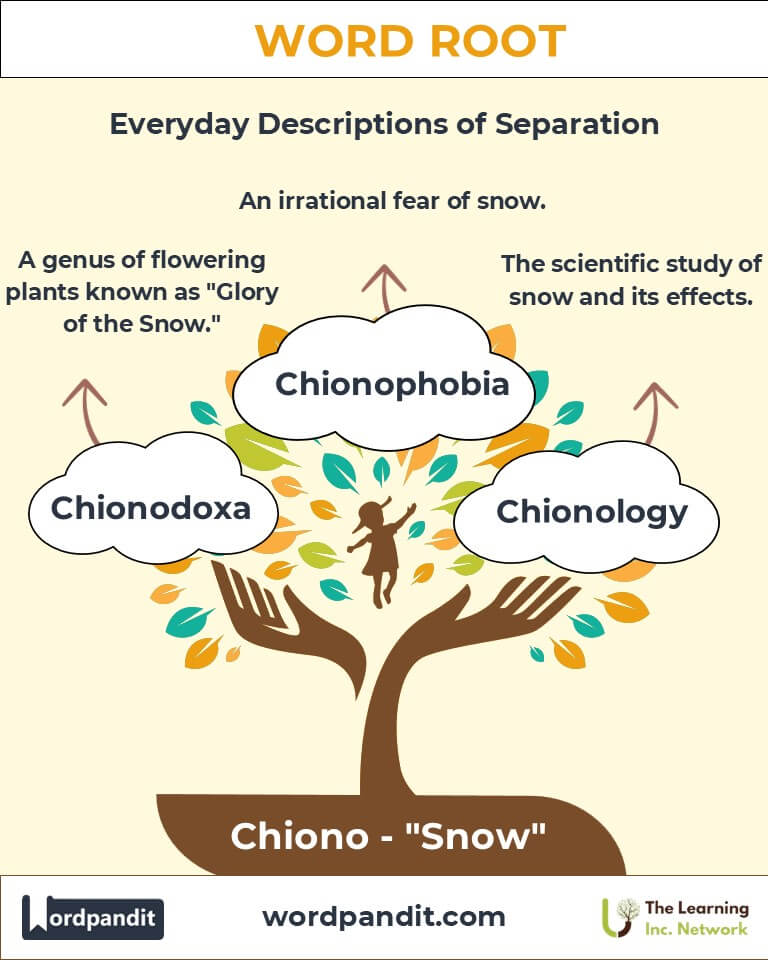Chiono: The Root of Snow in Nature and Language
Discover the beauty and wonder of the word root "Chiono," derived from the Greek word for snow. From delicate flowers like Chionodoxa to enthusiasts called Chionophiles, this root connects us to the purity, resilience, and magic of snowy landscapes.

Table of Contents
- Introduction: The Essence of Chiono
- Etymology and Historical Journey
- Mnemonic: Unlocking the Power of Chiono
- Common Chiono-Related Terms
- Chiono Through Time
- Chiono in Specialized Fields
- Illustrative Story: Chiono in Action
- Cultural Significance of Chiono
- The Chiono Family Tree
- Conclusion: The Living Legacy of Chiono
Introduction: The Essence of Chiono
Imagine a world blanketed in soft, white snow—tranquil, pristine, and brimming with natural beauty. The word root "Chiono," pronounced "kai-oh-no," comes from the Greek word for snow. This evocative root inspires words that celebrate the delicate yet transformative nature of snow. Whether in botany or human passion for snowy environments, "Chiono" symbolizes winter's quiet charm and profound resilience.

Etymology and Historical Journey
The root "Chiono" traces its origins to the Greek word chion (snow). Ancient Greeks often referenced snow in poetry and mythology, seeing it as both a cleansing force and a sign of divine power. Over centuries, the root expanded into scientific and cultural vocabulary, enriching disciplines such as botany and climatology.
Mnemonic: Unlocking the Power of Chiono
Picture a snow-covered field where delicate flowers bloom despite the cold. This image captures the heart of "Chiono"—the coexistence of beauty and resilience.
Mnemonic Device:
“Chiono chills the earth but warms the heart with snowy beauty.”
Common Chiono-Related Terms
- Chionodoxa (kai-oh-no-dok-suh): A genus of flowering plants known as "Glory of the Snow." These hardy blooms emerge early in spring, often through snow.
Example: "The Chionodoxa in my garden heralded the end of winter." - Chionophile (kai-oh-no-file): A person or organism that thrives in snowy environments.
Example: "As a chionophile, Jake eagerly awaited the first snowfall for his snowshoe hikes." - Chionophobia (kai-oh-no-foe-bee-uh): An irrational fear of snow.
Example: "Her chionophobia made winter trips challenging." - Chionology (kai-oh-nol-uh-jee): The study of snow, its formation, and its effects on ecosystems.
Example: "Advances in chionology have improved weather predictions in snowy regions."
Chiono Through Time
- Chionodoxa: These flowers were named in the 19th century, symbolizing resilience as they bloom even under snow.
- Chionophiles: From ancient times to modern explorers, humanity's love for snow has evolved into hobbies like skiing and snowboarding.
Chiono in Specialized Fields
- Botany: Chionodoxa represents plants adapted to cold conditions, highlighting the intersection of beauty and survival.
- Ecology: Chionophiles like polar bears and snow leopards exhibit unique adaptations for snowy habitats.
- Psychology: Chionophobia sheds light on how weather shapes human fears and behaviors.
- Climatology: Chionology aids in understanding snowfall patterns and their impact on global climates.
Illustrative Story: Chiono in Action
Amid a snowy mountain village, young botanist Lina embarked on a quest to study Chionodoxa flowers. Battling the cold, she marveled at how these blooms defied winter's harshness. Inspired, she wrote about their resilience, sharing insights that resonated with chionophiles worldwide. Her story became a testament to the root's enduring legacy of strength in adversity.
Cultural Significance of Chiono
Snow has captivated cultures for centuries, symbolizing purity, renewal, and impermanence. From Japanese haikus describing snow's quiet beauty to festivals like Quebec's Winter Carnival, the essence of "Chiono" transcends language, uniting us in awe of winter’s power.

The Chiono Family Tree
- Cryo- (cold, icy):
- Cryotherapy: Treatment using extreme cold.
- Cryosphere: The frozen parts of Earth.
- Frigo- (cold):
- Refrigerate: To cool or chill.
- Frigid: Extremely cold or unfriendly.
- Hiber- (winter):
- Hibernate: To spend winter in a dormant state.
- Hibernal: Relating to winter.
FAQs About the Chiono Word Root
Q: What does "Chiono" mean?
A: The root "Chiono" comes from the Greek word "chion," meaning "snow." It is used in words related to snowy environments, conditions, or adaptations.
Q: What is Chionodoxa?
A: Chionodoxa, or "Glory of the Snow," is a genus of flowering plants that bloom early in spring, often emerging through the snow. These hardy flowers symbolize resilience and beauty.
Q: What is a Chionophile?
A: A Chionophile is someone or something that thrives in snowy environments. This can include snow-loving people as well as animals adapted to snow-covered habitats, such as polar bears and arctic foxes.
Q: What is Chionophobia?
A: Chionophobia is an irrational fear of snow. It can be caused by traumatic experiences or concerns about snow-related dangers such as avalanches or icy roads.
Q: What is Chionology?
A: Chionology is the scientific study of snow, including its formation, physical properties, and effects on ecosystems. It is essential for weather forecasting and climate studies.
Q: How does "Chiono" apply to botany?
A: In botany, "Chiono" appears in the names of plants that thrive in snowy conditions. For example, Chionodoxa flowers bloom despite cold temperatures and snow cover.
Q: What is the cultural significance of snow in the context of "Chiono"?
A: Snow, represented by "Chiono," symbolizes purity, renewal, and transformation in many cultures. It is celebrated in literature, festivals, and traditions worldwide.
Q: Can "Chiono" help us understand climate change?
A: Yes, chionology helps scientists study snowfall patterns, melting rates, and their effects on ecosystems, which are critical for understanding climate change.
Test Your Knowledge: Chiono Mastery Quiz
1. What does "Chiono" mean?
2. What is Chionophobia?
3. Which flower is known as "Glory of the Snow"?
4. What does a Chionophile enjoy?
5. What field studies snow and its effects?

Conclusion: The Living Legacy of Chiono
The root "Chiono" beautifully captures the spirit of snow—serene, transformative, and resilient. From scientific studies to personal passions, its applications reveal our enduring fascination with winter’s wonders. As we celebrate the root's linguistic and cultural contributions, let "Chiono" remind us of nature's quiet strength and enduring beauty.











